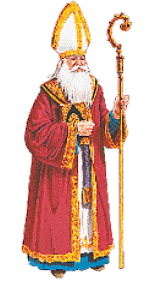 |
The story of Saint Nicholas
(the true story of Santa Claus)
Santa Claus, isn't a mythical figure of Christmas, who on the night
before Christmas, enters in the houses of all of the good boys and
girls, through the chimney, and leaves them presents under the
Christmas tree and fills their stockings with candy and toys.
The true Santa Claus was born a long time ago, around 270 AD in a
place called Patara, a village in what is now Turkey. His name was
Nicholas and he became Bishop of Myra. |
Nicholas' parents died when he was just a teenager and he went to
live with his uncle who was a priest. Nicholas' parents were rich
and after they died, left him much money. He wanted to use his
wealth to help the poor people, in fact, little by little, Nicholas
gave all of his fortune away.
His generosity was legendary, for this reason many legends arose
about him.
In the most famous story about Nicholas we find two of the basic
principles of the Christmas spirit - to give for helping the less
fortunate - as well as the tradition of hanging stockings by the
fireplace.
This famous legend tells of a poor man that had three daughters.
This father had lost his job and he had no money to buy food for his
daughters. All three girls were very pretty and old enough to get
married, but they couldn't because their father had no dowry to give
to the possible husband's family. (The dowry is a sum of money or
some valuable property; such payment was necessary in order to marry
in the ancient world).
This father was worried for his daughters, and he had decided to
sell his daughters as slaves to save all them, to starve.
According to this legend, one day, the good Nicholas felt to speak
of this family and wanted to help them, but secretly, because he
never wanted attention on himself or thanks.
The night before the girls was to be sold, Nicholas went to poor
man's house, with three bags of gold coins, one for every dowry of
the three daughters. That evening, before going to sleep, the three
sisters had washed the clothes and they had hung them in front of
the fireplace to dry. One by one, Saint Nicholas dropped the bags
down the chimney, and miraculously the bags didn't fall on the floor,
but in the stockings of every daughter. The following morning, when
the three daughters woke up, they found in their stockings, one
small bag with the gold coins. Enough to provide food for the family
and money for their dowry.
And so, through the goodness of Nicholas
Saint, all three daughters were able to be married.
Nicholas was loved in many countries for his generosity, his love
for children and after his death (around
345 AD), he became the
Saint
|
patron of children and unmarried girls, of sailors, scholars,
bankers and he became also the national patron Saint of Russia and
Greece.
Saint Nicholas is also known as Nicholas of Bari, because in 1087
A.D., some Italian merchants stole his bones at Myra and brought them to
Bari in Italy, where a beautiful cathedral was built in his honour.
Saint Nicholas remained popular in Europe throughout the centuries,
he was called Sankt Nikolaus in Germany and Sanct Herr Nicholaas or
Sinter Klaas in Holland. |
 |
When the Dutch settlers went to America in the 17 century, they also
brought together with their traditions, the legend of Sinter Klaas and
maintained their custom of celebrating the saint's feast day on December 6th.
They told their children that the Saint, a thin man with a flowing white beard,
dressed in red bishop's robes, visited their houses and left presents, for the
little boys and girls, on Saint Nicholas Eve.
At that time, English settlers adopted the legends and festivities associated
with Saint Nicholas. When English-speaking children quickly pronounced the name
of Sinter Klaas, it sound like "Sainty Claus", and so, during the course of the
years, it evolved in Santa Claus.
Saint Nicholas was slowly being transformed in America.
The first description "literary" of Sant Nicholas was had by the
book "History in New York", published in 1809, of Irving Washington in which he
described him as as a plump and jolly Dutchman.
Few years later, in 1822, he was transformed again, by Clement C.
Moore that wrote, for his children, the famous poem "A Visit From St. Nicholas",
more commonly known as "The Night Before Christmas" that it was published
without Moore’s permission, in a New York newspaper in 1923. This poem became
very popular in the United States.
Moore described the generous gift-giver as a curious little elf who
comes into the house down chimneys and flies through the air in a sleigh pulled
by eight reindeer called, Dasher, Dancer, Prancer, Vixen, Comet, Cupid, Donder
and Blitzen (Moore’s elf also smoked a pipe)
The American image of Santa Claus was still elaborated by
illustrator Thomas Nast, who depicted a rotund Santa for Christmas issues of
Harper's magazine from the 1860s to the 1880s. Nast added many other details as
Santa's workshop at the North Pole, Santa's list of the good and bad children of
the world and dressed him in red fur-trimmed robes.
The Santa Claus we know today was painted in 1931 by Haddon Sundblom
for an advertising campaign by the Coca - Cola company.
He completed the transformation of Santa Claus, from a friendly old
elf to full-sized human, complete with plump belly, sympathetic face, jovial
air, and debonair bearing and since then, it has become the "traditional" Santa
Claus all over the world, but ...
|
Every time that we see an image of Saint Claus remember ourselves of
his true origin, remember ourselves Sant Nicholas: his love for the
others and his goodness. |
|